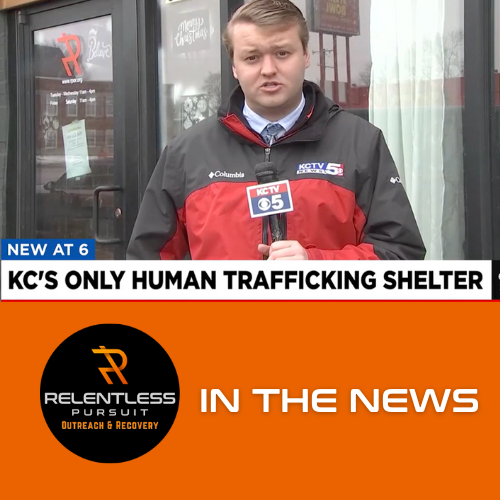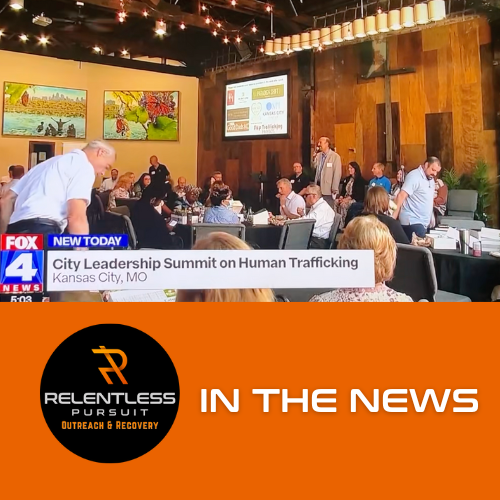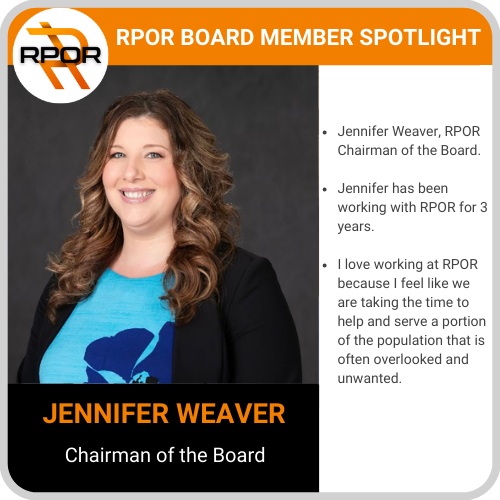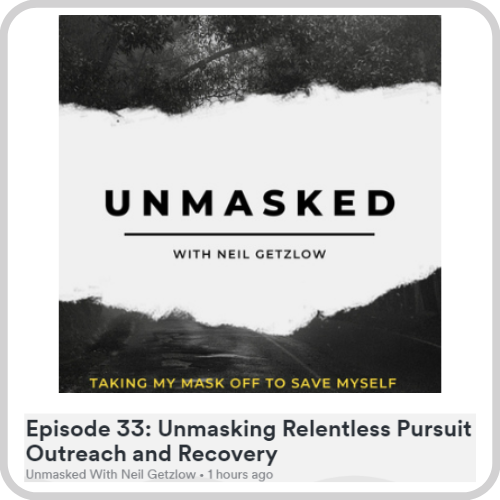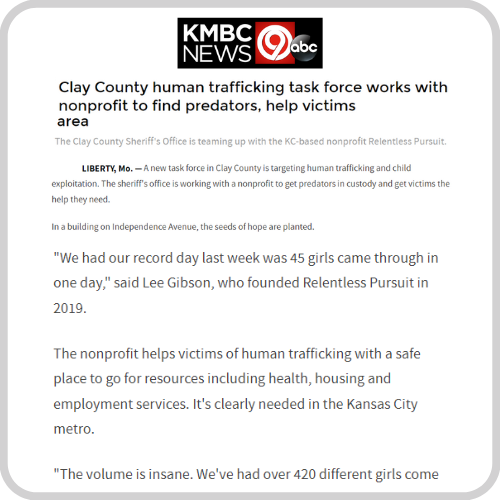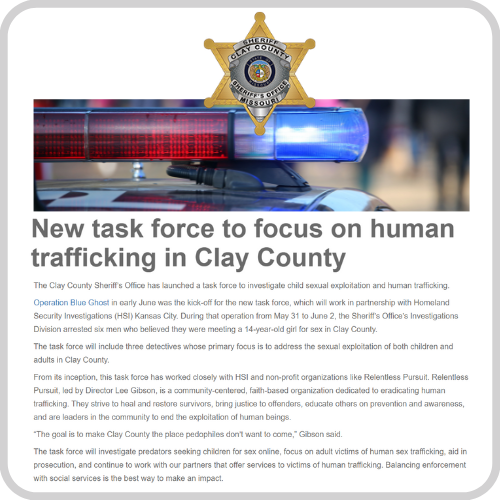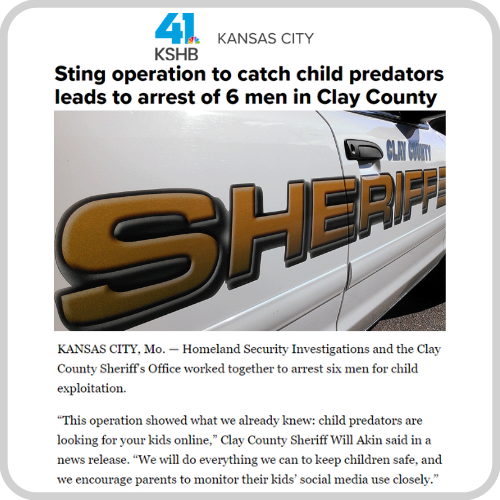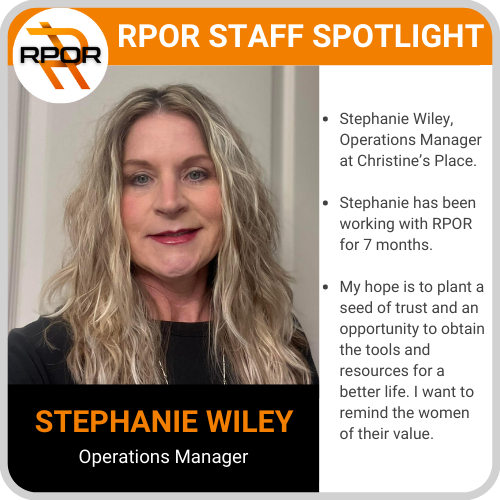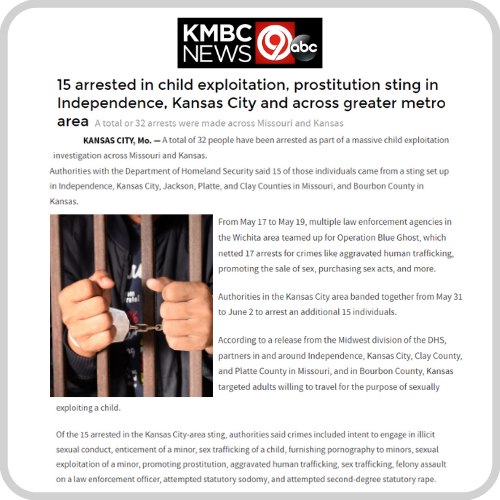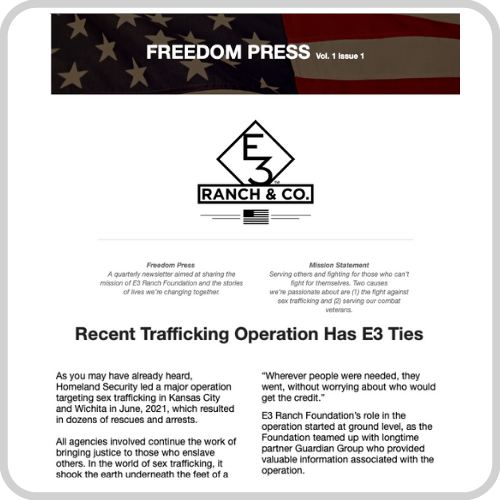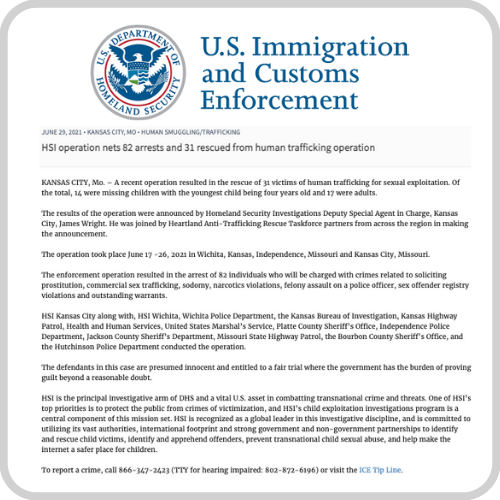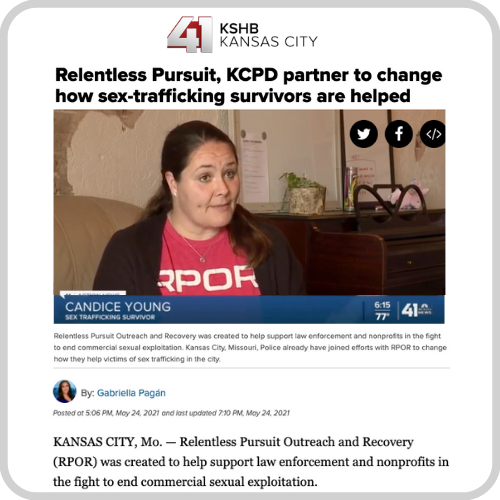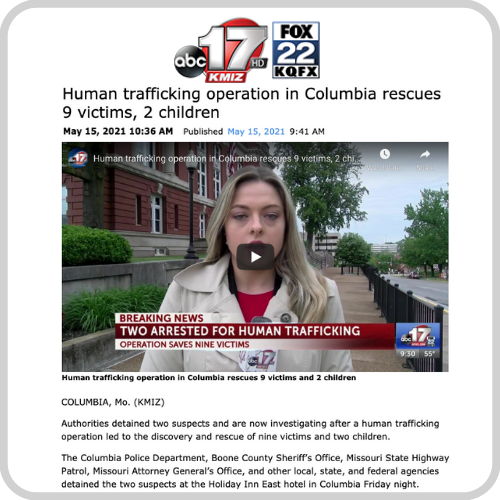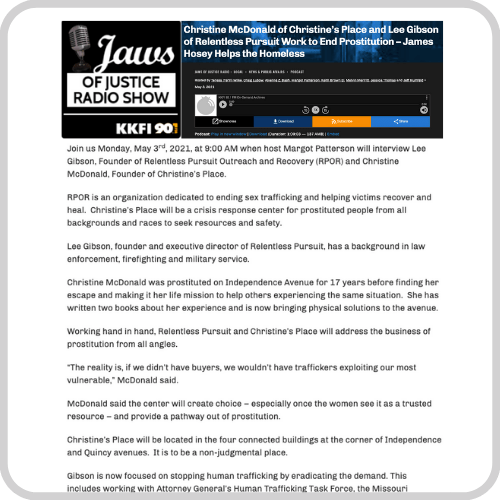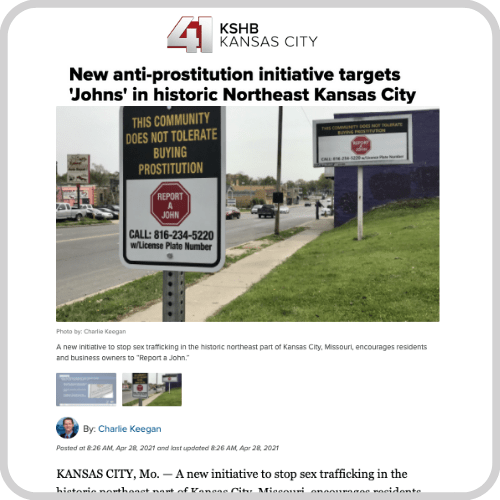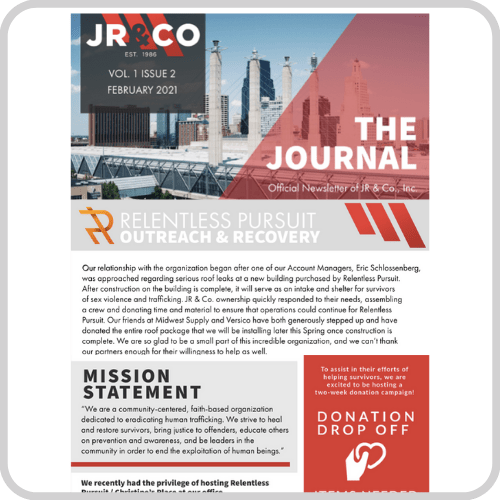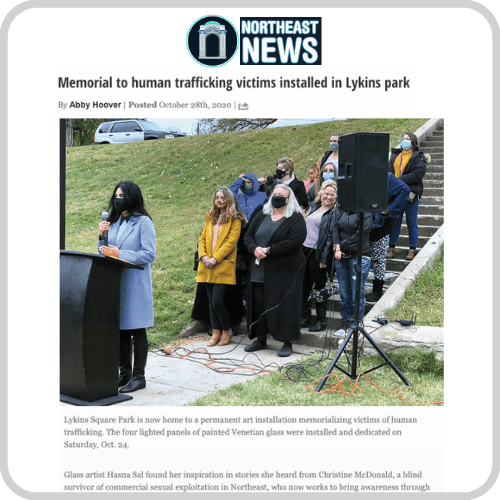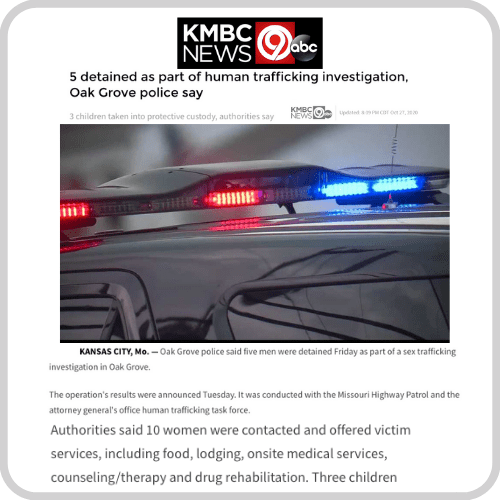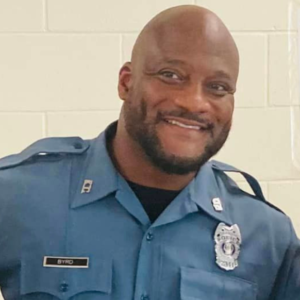
According to the Trafficking Victims Protection Act of 2000 (TVPA) and its 2003, 2005, and 2008 reauthorizations, human trafficking has occurred if a person was induced to perform labor or a commercial sex act through force, fraud, or coercion. Any person under age 18 who performs a commercial sex act is considered a victim of human trafficking, regardless of whether force, fraud, or coercion was present.
HUMAN TRAFFICKING STATISTICS
HUMAN TRAFFICKING STATISTICS
Due to the “hidden” nature of trafficking activities, gathering statistics on the magnitude of the problem is a complex and difficult task.
The following statistics are the most accurate available, given these complexities, but may represent an underestimation of trafficking on a global and national scale.
Each year, an estimated 600,000 to 800,000 men, women, and children are trafficked across international borders (some international and non-governmental organizations place the number far higher), and the trade is growing. (U.S. Department of State. 2004. Trafficking in Persons Report. Washington, D.C.: U.S. Department of State.)
Of the 600,000-800,000 people trafficked across international borders each year,
70 percent are female and 50 percent are children.
Female
Children
The majority of these victims are forced into the commercial sex trade. (Ibid.)
Each year, an estimated 14,500 to 17,500 foreign nationals are trafficked into the United States. The number of U.S. citizens trafficked within the country each year is even higher, with an estimated 200,000 American children at risk for trafficking into the sex industry. (U.S. Department of Justice. 2004. Report to Congress from Attorney General John Ashcroft on U.S. Government Efforts to Combat Trafficking in Persons in Fiscal Year 2003. Washington, D.C.: U.S. Department of Justice.)
The largest number of people trafficked into the United States come from East Asia and the Pacific (5,000 to 7,000 victims).
The next highest numbers come from Latin America and from Europe and Eurasia, with between 3,500 and 5,500 victims from each.
(U.S. Departments of Justice, Health & Human Services, State, Labor, Homeland Security, Agriculture, and the U.S. Agency for International Development. 2004. Assessment of U.S. Government Activities to Combat Trafficking in Persons. Washington, D.C.: U.S. Department of Justice.)
HUMAN TRAFFICKING INDICATORS
HUMAN TRAFFICKING INDICATORS
People who have been trafficked and sexually exploited may:
- Believe they must work against their will
- Show fear & anxiety
- Suffer injuries or impairments (typical of certain jobs, control measures, or assault)
- Be distrustful of authorities
- Not know their home or work address
- Work long hours or have few or no days off
- Be of any age (Although the age may vary according to the location and the market)
- Live or travel in a group
- Have tattoos or other marks indicating “ownership” by their exploiters
- Be escorted whenever they go to and return from work and other outside activities
- Have an older boyfriend
- Have new friends with a different lifestyle than their own and be involved in a gang
TRAFFICKING IN PERSONS IS A HEINOUS CRIME AND HUMAN RIGHTS ABUSE
The most vulnerable members of the global community, those who have limited access to social services and protections, are targeted by traffickers for exploitation. Steps have been taken, however, to locate victims, reinstate their inherent rights, provide them with protection and services, and prosecute offenders.
No country is immune from human trafficking. Victims are forced into prostitution or to work in quarries and sweatshops, on farms, as domestics, as child soldiers, and in many forms of involuntary servitude. Traffickers often target children and young women. They routinely trick victims with promises of employment, educational opportunities, marriage, and a better life. (U.S. Department of State. 2004. Trafficking in Persons Report. Washington, D.C.: U.S. Department of State.)
Human trafficking is the third most profitable criminal activity, following only drug and arms trafficking. An estimated 9.5 billion is generated in annual revenue from all trafficking activities, with at least $4 billion attributed to the worldwide brothel industry. (Ibid.)
HUMAN TRAFFICKING SITUATIONS
RED FLAG SCENARIOS
The following scenarios might be red flags for relationships or jobs that may develop into human trafficking. One or more of these may indicate that an individual is at-risk for sex or labor trafficking. This list is not exhaustive.
- Comes on very strongly and promises things that seem too good to be true – i.e. promises extremely high wages for easy work.
- Expects that you will agree to the employment or relationship on the spot, and threatens that otherwise the opportunity will be lost.
- Is unclear about the terms of employment, location of employment and/or the company details/credentials. Partner/employer denies access to information about your rights.
- Denies contact with friends or family or attempts to isolate you from your social network.
- Constantly checks on you and does not allow you access to your money.
- Asks you to do things outside of your comfort zone such as performing sexual favors for friends.
- Displays signs/characteristics of a dangerous person including: attempts to control movement and behaviors, exhibits jealousy, lashes out or delivers punishment in response to noncompliance, is verbally/emotionally/physically abusive.
- Uses threats or displays of violence to create a culture of fear.
TIPS TO STAYING SAFE IN TRAFFICKING OR DANGEROUS SITUATIONS
GENERAL SAFETY TIPS
GENERAL SAFETY TIPS
- Trust your judgment. If a situation/individual makes you uncomfortable, trust that feeling.
- Let a trusted friend or relative know if you feel like you are in danger or if a person or situation is suspicious.
- If possible, set up safety words with a trusted friend/relative.
- One word can mean that it is safe to talk and you are alone.
- A separate word can mean you are not safe.
- * It is also important to communicate what you would like done (cease communication immediately, call 9-1-1, meet somewhere to pick you up, etc.).
- Keep all important documents and identification in your possession at all times. Your partner/employer does not have the right to take or hold your documents without your permission.
- Keep important numbers on your person at all times, including the number of someone you feel safe contacting if you are in trouble.
- Make sure that you have a means of communication (cell phone or phone card), access to your bank account, and any medication that you might need with you at all times.
- If you think you might be in immediate danger or you are experiencing an emergency, contact 9-1-1 first.
SAFETY TIPS: When Leaving A Human Trafficking Situation
SAFETY TIPS: When Leaving A Human Trafficking Situation
In some cases, leaving or attempting to leave a trafficking situation may increase the risk of violence. It is important to trust your judgment when taking steps to ensure your safety.
If you are ever in immediate danger, the quickest way to access help is to call 9-1-1.
- If you are unsure of your current location, try to determine any indication of your locality such as street signs outside the residence or place of employment, or newspapers/magazines/mail that may have the address listed.
- If it is safe to go outside, see if the address is listed anywhere on the building.
- If there are people nearby and it is safe to speak with them, ask them about your current location.
- Plan an escape route or exit strategy and rehearse it
- Keep any important documents on or near you to be ready for immediate departure.
- Prepare a bag with any important documents/items and a change of clothes.
- Keep a written copy of important numbers on you at all times in case your phone is taken or destroyed at any point. Memorize important numbers/hotlines.
- Think about your next steps after you leave the situation.
- Contact trusted friends or relatives to notify them or to ask for assistance if you feel comfortable.
- Contact the National Human Trafficking Hotline 24-hour hotline at 1-888-3737-888 to obtain local referrals for shelter or other social services and support. The Hotline can also connect you with specialized law enforcement referrals. However, if you are ever in immediate danger, contact 9-1-1 first.
- Think about your next steps after you leave the situation.
- Contact trusted friends or relatives to notify them or to ask for assistance if you feel comfortable.
- Contact the National Human Trafficking Hotline 24-hour hotline at 1-888-3737-888 to obtain local referrals for shelter or other social services and support. The Hotline can also connect you with specialized law enforcement referrals. However, if you are ever in immediate danger, contact 9-1-1 first.
- During violent or explosive situations avoid dangerous rooms
- Examples of Dangerous Rooms: kitchen (knives, sharp utensils, pots), garage (tools, sharp objects), bathroom (hard surfaces, no exits), basement (hard surfaces, no exits), rooms where weapons are kept and rooms without an exit.
- Examples of Safer Rooms: front room, yard or apartment hallway where a neighbor might see or hear an incident.
- Develop a special signal (lights flickering on and off, code word, code text message, hand signal, etc.) to use with a trusted neighbor, relative, friend or service provider to notify them that you are in danger.
- It is important to proactively communicate what action steps you would like taken (call 9-1-1, check-in, pick the children up, etc.).
- If you have children who are also in the trafficking situation, explain to them that it isn’t their responsibility to protect you, and make sure that they know how to call someone for help, where to hide during a violent incident, and practice your plan of departure with them.
SAFETY TIPS: After Exiting A Human Trafficking Situation
SAFETY TIPS: After Exiting A Human Trafficking Situation
- Keep your residence locked at all times. Consider changing your locks if the controller has a key or may be able to access your residence.
- If moving to a new residence, only disclose your address to people that you trust and consider accessing the Address Confidentiality Program (ACP).
- Consider taking out a protective order against the controller so that he/she will be legally prohibited from contacting you.
- While options vary by location, you can typically obtain a protective order civilly without talking to or involving law enforcement.
- Contact the National Human Trafficking Hotline at 1-888-3737-888 to find the service provider nearest you that can assist you in long-term safety planning, including taking out a protective order or accessing the ACP in your state.
- If the controller has made unwanted contact, document the contact made (calls, texts, showing up at your work/home, etc.) and save any voicemails and text messages that are threatening in nature.
- Consider changing your phone number to a number unknown by the controller. Most cell phone carriers will allow you to block individuals or to change numbers at no or low cost.
- Keep a cell phone or emergency phone on you at all times. If you feel comfortable, tell your neighbors, employer, or friends to call the police if they see the controller near, in, or around the residence
SAFETY TIPS: For Communicating With Someone In A Trafficking Or Dangerous Situation
SAFETY TIPS: For Communicating With Someone
In A Trafficking Or Dangerous Situation
When communicating with someone in a dangerous or potential trafficking situation:
- Recognize that the person in the situation knows their situation best, and it is necessary to honor their requests to ensure their safety
- Maintain open and nonjudgmental communication, ensuring they know they can reach out at any time, and end the call when they need to
- Try to speak in person if possible
- If that is not possible, try to speak on the phone first [rather than via text or social media messaging] and ask if the person is alone, and then use yes/no questions until they indicate it is safe to communicate more freely
- If they are alone, try to establish safety words: one word to indicate it is safe to talk/the person is alone [for future communications] and one to indicate it is no longer safe to talk and what the person in the situation would like done [cease communication immediately/contact law enforcement/etc.]
- Try to learn more about safety concerns
- Try to learn more about their needs/wishes moving forward [reporting, shelter, counseling, legal services, etc.]
JOIN OUR CAUSE
JOIN OUR CAUSE

We seek to create a world free from sexual exploitation through enacting justice, providing recovery and training, and educating the public.
Change is possible!
RPOR
IN THE NEWS

BE A PART OF THE SOLUTION







